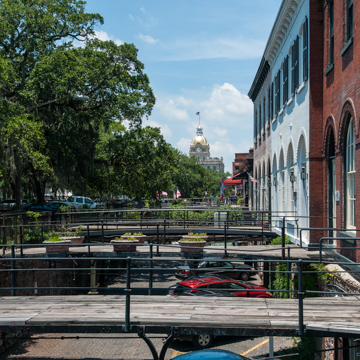Savannah's historic riverfront straddles a forty-foot bluff creating a unique ensemble of buildings, cobbled ramps, stone retaining walls, terraced lanes, and more than forty iron and wooden bridges. The row of historic warehouses, stretching for almost a mile, constitutes one of the best preserved nineteenth-century waterfronts in the country, interrupted for only one block by the modernist Savannah Hyatt Regency Hotel. Development began below the bluff, with warehouses appearing by 1744 and the first wharf in 1759. The first warehouse to rise above the top of the bluff, Commerce Row, was built in 1789. An 1804 hurricane destroyed nearly all of the warehouses, leading to a city ordinance that banned the use of exterior wood construction for these structures and resulted in a majority using stone or brick for walls, with wooden mill construction for interior supports and floors. Most of the extant warehouses were erected in the prosperous 1850s.
In contrast to the orthogonal nature of the Savannah plan, the wharf lots developed in an arc paralleling the river. River Street was created in 1834 and preserves the city's longest stretch of granite "Belgian blocks," a common pavement by the late 1800s, so named because originally they were quarried in the Low Countries and squared to fit between the ribs of sailing ships as ballast. The south side of the warehouses became known as Factors' Walk, denoting the cotton planters' agents (or factors), whose offices occupied the upper floors of the warehouses. With one formal facade looking south to the city (but with subterranean lanes for the passage of cotton wagons) and a towering work facade facing north toward the Savannah River, no spot better depicts the diverse business duties of the port. During the second half of the nineteenth century, warehouse construction extended along the river beyond the edges of downtown.
The retaining walls and ramps of Savannah's waterfront are a vivid reflection of the relative imbalance in the city's trade. Departing ships carried the lowcountry's abundant rice, cotton, or naval stores, but they arrived comparatively empty, save for ballast stones. The earliest reference to a stone retaining wall north of Bay Street dates to 1820, but the majority of the random ashlar walls appear to have been constructed between 1855 and 1858 by Michael Cash, an Irish contractor and masterful stonemason. During the Civil War, however, they were partially dismantled by the occupying Union forces and deposited in the river to make it impassable to Confederate ships. As documented by various stone plaques embedded in the walls, they were reconstructed by Cash in 1866. The many cast- and wrought-iron bridges linking the upper stories of the warehouses to the top of the bluff, mostly dating from the late 1800s, exhibit varied structural methods, including bow-string, box, and arched trusses.




















